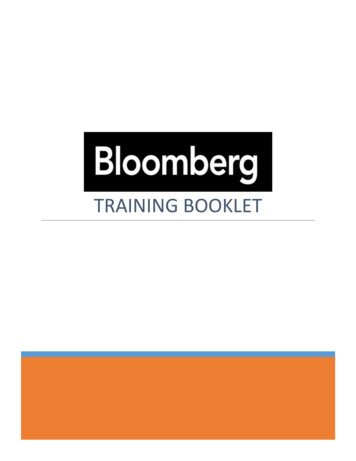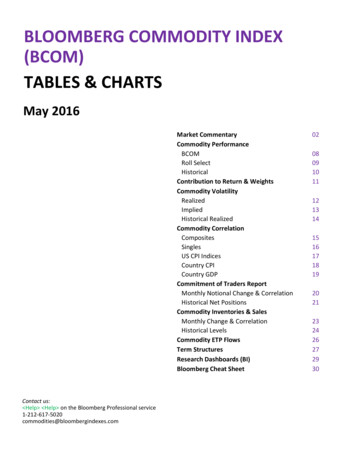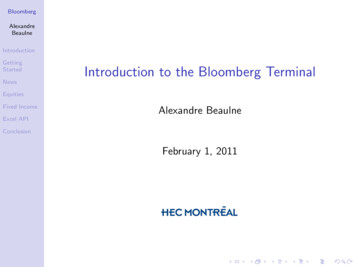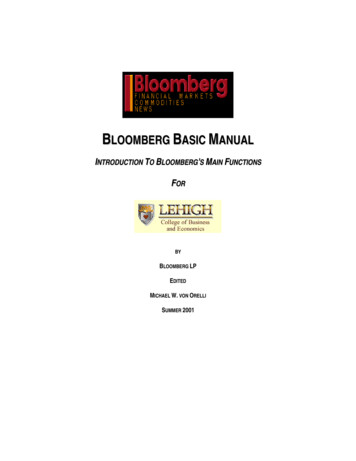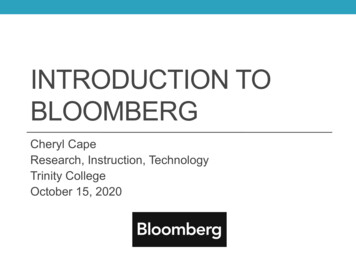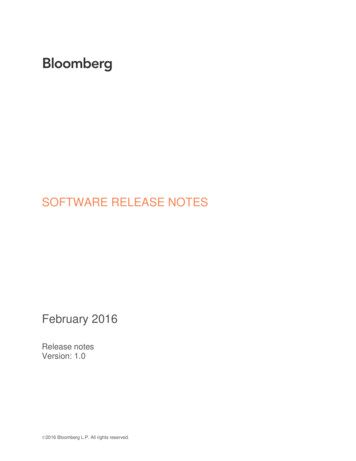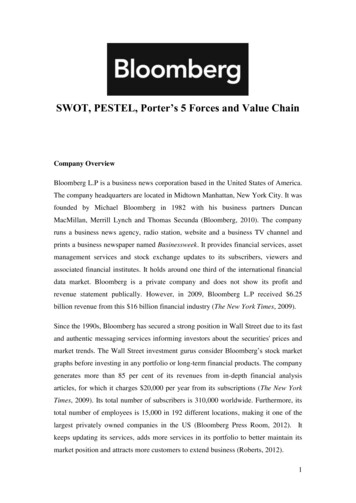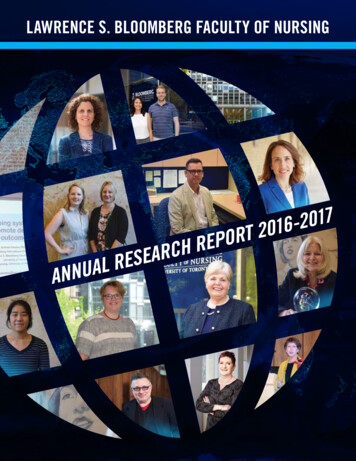
Transcription
LAWRENCE S. BLOOMBERG FACULTY OF NURSING
DEAN’SMESSAGECONTENTSASSOCIATEDEAN’S MESSAGEMeet theResearch Faculty . 3Bloomberg Nursingby the Numbers. 4New Faculty Appointment . 5Improving Maternaland Infant Health. 6HAVING A GLOBAL IMPACTOUR PLACE IN THE WORLDBgain this year, QS WorldUniversity Ranking by Subjectranked Bloomberg Nursing #1 inCanada among schools of nursing.Much of this ranking emergesfrom our research citations. Thisis impressive given the competitive healthcare research fundingenvironment in Canada.Some funding opportunities havedeclined in frequency. Others haveclosed entirely. There are few newinvestigator competitions now, andwe have always been successful atobtaining funding support for ouremerging scholars.Despite these challenges,Bloomberg Nursing has not onlysustained its leadership in research,it has improved its research output.Our researchers consistently publishin top-ranked journals, as do ourdoctoral and post-doctoral students.And our faculty members continueto be recognized with internationalawards and distinctions.Bloomberg Nursing’s continuedresearch leadership attracts thetop students and researchers fromaround the globe.Linda Johnston, PhD, FEANS, FAANDean, Bloomberg Nursing2Healthcare offthe Beaten Path. 10ALinda McGillis Hall, RN, PhD, FAAN, FCAHSAssociate Dean, Research& External RelationsAccentuating the Positive . 11The Cardiac Gender Divide. 12Forum Attracts EmergingNurse Researchers . 14Our International Reach. 16BuildingFuture Researchers . 18Awards and Distinctions. 19Research Collaborations. 20Research Funding Awarded,2016–2017 . 22Publications . 30Research Impact Spotlight. 38PHOTOS: JEFF KIRKloomberg Nursing’s newStrategic Academic Plan makesinternationalization a priority andembeds it across all of our domainsof activity, including research.International research collaborations offer multiple benefits.They allow researchers to maximizetheir research expertise by partnering with universities in differentcountries. They enhance the volumeand quality of research by increasing access to international fundingsources. They also enable researchfindings to go from having a localinfluence to having a global impact.We recently signed an Erasmus agreement with the Universitat deLleida that will give MN and PhDstudents the opportunity to studyin Spain where they can gain newunderstandings and be exposed todifferent research methodologies.Having lived and worked inseveral countries around the world,I’ve come to understand that thehealthcare priorities are the same nomatter where you are. Researchersin all countries are working towardthe same thing: health for all.Preventing and ManagingProcedural Pain in Infants . 8PUBLISHEREDITOR AND WRITERLINDA McGILLIS HALLSUSAN PEDWELLDESIGN GIL MARTINEZfor BIGGUYSTUDIO.CAASSOCIATE EDITORAND PHOTOGRAPHERLINDSAY CURTISEDITORIAL ASSISTANTMARIAN SMITHLAWRENCE S. BLOOMBERG FACULTY OF NURSING
MEET THE RESEARCH FACULTYPROF. ARLENE BIERMANPROF. SAMANTHA MAYOPROF. BONNIE STEVENSImproving access, quality of care and outcomes for older adults with chronic illnessOptimizing long-term healthof cancer survivorsAssessment and managementof pain in infants and oronto.cabonnie.stevens@sickkids.caPROF. KRISTIN CLEVERLEYPROF. LINDA McGILLIS HALLPROF. JENNIFER STINSONMental health nursing practice,research and educationNurse workforce policy, workenvironments and patient safetyPain and symptom management ofchildren and youth with chronic .cajennifer.stinson@sickkids.caPROF. LISA CRANLEYPROF. KATHERINE McGILTONPROF. ROBYN STREMLERKnowledge translation supportinghealthcare providers’ decision-makingEnhancing care of the older adultwith cognitive impairmentImproving sleep and health outcomesin infants, children and carobyn.stremler@utoronto.caPROF. CRAIG DALEPROF. KELLY METCALFEPROF. ANN TOURANGEAUFundamental nursing care needsof acute and critically ill adultsPrevention and treatment ofhereditary breast and related cancersNursing-related determinantsof health care nto.caann.tourangeau@utoronto.caPROF. CINDY-LEE DENNISPROF. CARLES MUNTANERPROF. KIM WIDGERMaternal and paternal health outcomesand postpartum depressionSocial inequities in health, socialepidemiology and health disparitiesImproving paediatric palliativeand end-of-life ronto.cakim.widger@utoronto.caPROF. DENISE GASTALDOPROF. SIOBAN NELSONHealth as a social phenomenon,with focus on migration and genderHistory of the nursing to.caPROF. MONICA PARRYThe health of women and newbornsfrom a global perspectiveSupportive care to improve health outcomes for those with chronic to.caPROF. DORIS HOWELLPROF. ELIZABETH PETEROptimizing quality of cancer careand empowering patientsEthical concerns in community nursing,especially home PROF. LIANNE JEFFSPROF. MARTINE PUTSPatient safety, quality improvementand knowledge translationGeriatric frailty and oncology,and the health of older adultsjeffsl@smh.camartine.puts@utoronto.caPROF. LINDA JOHNSTONPROF. LOUISE ROSEPain management and long-term outcomes in the neonatal care environmentCare and management of patientsrequiring mechanical ronto.caJOURNAL ARTICLESAWARDS ANDDISTINCTIONSICONS: SHUTTERSTOCKPROF. EDITH HILLANANNUAL RESEARCH REPORT 2016-2017PUBLICATIONS & AWARDS SUMMARYBOOK CHAPTERS3
#1#6BLOOMBERG NURSING BY THE NUMBERSin North Americafor most citatedin nursingpublicationsNURSING FACULTYIN CANADA(QS RANKINGS,2017)Nursing Facultyin the World(QS RANKINGS, 2017)Fellows of theCanadian Academyof Health Sciencesundergraduatestudents partneredwith faculty researchersin Summer 201625Cochrane reviews4journal articlespublished infaculty members involved ininternational research collaborations23high-impactjournalsNumber of countries we haveresearch relationships withFellows of the AmericanAcademy of NursingLAWRENCE S. BLOOMBERG FACULTY OF NURSING
NEW FACULTY APPOINTMENTCraig Dale’s research buildsthe evidence base for improvingthe oral care of critically illpatientsCraig Dale joined the Lawrence S.Bloomberg Faculty of Nursing as an Assistant Professor in 2014. In 2016, his researchproposal to the Canadian Institutes for HealthResearch (CIHR) ranked second among theapplications that the committee reviewed, andhe received the Embedded Clinician ResearcherAward.This 300,000 award, delivered over fouryears, gives Dr. Dale the opportunity to dedicatea portion of his time to research. He is now engaged as the CIHR embedded clinician scientistin oral health at Sunnybrook Health SciencesCentre, an internationally renowned researchhospital affiliated with the University of Toronto.As a clinician researcher, Dale is developinghis program of research by investigating howto improve the delivery of oral care to adults inintensive care units. He’ll use innovative methods, including videography, to understand howpatients and healthcare professionals approachthis aspect of care.“The issue of oral care is crucial,” says Dale. “Inits most serious manifestation, poor oral health canlead to higher rates of infection, such as pneumonia, and thus longer hospitalizations and highermortality for patients. Poor oral care can also leadAnd Dale’s international profile is growing. In 2015,to significant dental complications. For adultshe was appointed a member of the Internationalwithout dental coverage, the dental treatments that Learning Collaborative (ILC), which was establishedare needed to manage thesein 2008 as a joint collaboracomplications can be expenCurriculum Vitaetion between the Universitysive, if not out of reach.”of Adelaide in Australia andDale is enriching hisGreen Templeton College ofCR AIG DA LEresearch program with athe University of Oxford inBloomberg Nursingvariety of collaborations. Forthe United Kingdom. ILC’s› Postdoctorate 2014example, his appointmentgoal is to unite all involved› PhD 2013as a Scientist with the U of Tin healthcare to improve theRyerson University, TorontoCentre for the Study of Painstandard of the fundamentals› BSc 2006allows him to focus onof care in high-technologypain related to oral health.environments. nANNUAL RESEARCH REPORT 2016-201733%Percentage ofICU patients whoreceive invasiveventilation5
IMPROVING MATERNAL AND INFANT HEALTHProfessor Cindy-Lee Dennis is an international authorityon breastfeeding and postpartum depressionIn June 2016, Cindy-Lee Dennis was appointedto the Women’s Health Research Chair at U of Tand St. Michael’s Hospital. The chair enables Dennisto further her research program that emphasizesWILL BE HIGHLYimproving breastfeeding outcomes, preventing andANXIOUS DURINGtreating perinatal depression and anxiety, examinPREGNANCYing the health of immigrant women and children,and developing interventions that involve fathers.It’s not the only chair she holds. Dr. Dennis alsohas the distinction of holding a Canada ResearchChair in Perinatal Community Health at U of T.“Time is very precious to researchers, and bothchairs enable me to fully engage in my researchprogram,” she says.The chairs foster exchange, partnership anddialogue with researchers, clinicians and decision-makers around the world. Currently, Dennisis a co-investigator on more than 26 studies incountries as diverse as Australia, Cuba, Brazil,Sweden, India, South Africa and the UnitedKingdom.Her research has informed the Ontario Ministry of Child and Youth Services’ “Healthy BabiesHealthy Children” program, which assessesthe majority of new mothers in the province forpostpartum depression (PPD). But the influenceof her research extends farbeyond Canada. For herCurriculum Vitaemaster’s thesis, Dennisdeveloped the BreastfeedingCINDY-LEE DENNISSelf-Efficacy Scale. Since itUniversity of British Columbia,was published in 1999, it hasVancouverbecome the most widely used› Postdoctorate 2002breastfeeding scale in theworld, with researchers andBloomberg Nursingclinicians in more than 30› PhD 1999countries using it to identifyUniversity of Western Ontario,mothers at high risk of disLondoncontinuing breastfeeding.› MScN 1995“The scale has providedBloomberg Nursingmany international research› BScN 1991opportunities,” says Dennis.“It has been translated into6more than 20 languages, and every day someonecontacts me for permission to use it.”Last year, the International Consortium forHealth Outcomes Measurement, which is dedicated to transforming healthcare systems worldwideby measuring and reporting patient outcomes in astandardized way, included Dennis’ BreastfeedingSelf-Efficacy Scale in its pregnancy and childbirthpublication. This is further increasing the international use of her scale.INTO THE LIGHTFunded by the Canadian Institutes of Health Research, Dennis has just completed recruiting 6,400postpartum women and their partners across Canada to advance our understanding of the mediatingand moderating effects of single (maternal or paternal) parental PPD in contrast to dual (maternaland paternal) parental PPD on child development.Four PPD risk models (no parental PPD, maternalonly PPD, paternal only PPD, dual parental PPD)are being tested. The study results will produceurgently needed, innovative knowledge that willassist in the development of targeted interventionsbased on whether the family has one or two parents with PPD and whether the depressed parent isthe mother or the father.“Much of the perinatal mental health researchhas, unfortunately, excluded fathers despite goodevidence suggesting that approximately one in 10fathers experiences PPD,” says Dennis. “This studywill help move paternal mental health out of theshadows.”In addition, Dennis is examining other common mental health problems in the perinatal period that have also been ignored. She just publishedthe first meta-analysis examining the prevalenceof antenatal and postnatal anxiety. Overall, 102studies conducted in 34 countries were included,and the results suggest that one in four womenhas a high level of anxiety during pregnancy; thisratio decreases to one in six women in the first yearLAWRENCE S. BLOOMBERG FACULTY OF NURSING
PHOTO: JEFF KIRKWILL DEVELOPPOSTPARTUMDEPRESSIONAFTER HIS PARTNERGIVES BIRTHpostpartum. Rates were significantly higher inlow- to middle-income countries. She is also conducting research on co-morbidity where womenare both highly depressed and anxious and havevery poor clinical outcomes.PEERS CAN HELPDennis has developed innovative ways to preventPPD. One of her randomized controlled trialsfound that telephone-based support from trainedmothers who had previously experienced PPD cutthe rate of PPD by 50 per cent in new motherswith beginning depressive symptoms. “Peers cannormalize difficulties while also providing encouragement, positive feedback and a sense of belonging,” says Dennis. “They can help new mothersovercome loneliness and isolation.” She has alsoshown that telephone-based peer support cansignificantly increase breastfeeding duration andexclusivity rates.ANNUAL RESEARCH REPORT 2016-2017“I’m looking forward to continuing to find waysto improve the health of women and infantsnot just in Canada, but globally as well.”– Professor Cindy-Lee DennisHer research has inspired other investigators tolook for new ways to prevent PPD. At the EmergingNurse Scholars Forum that Bloomberg Nursinginitiated to support the early-career development ofnurse researchers around the world, Dennis metShefaly Shorey from Singapore in 2015. Shoreyasked Dennis to be a mentor, and now Shorey is designing, developing and testing the “Home But NotAlone” app for new parents. “Shefaly is replicatingthe effect of peer support using a different mode,”explains Dennis. In April 2017, Shorey, Dennis andothers published the study in the Journal of AdvancedNursing. n7
PREVENTING AND MANAGING PROCEDURAL PAIN IN INFANTSThe Canadian Institutes of Health Research awarded Professor Bonnie Stevensa seven-year Foundation grant to further her research programIn July 2016, Professor BonnieStevens embarked on a seven-yearresearch program focused on preBONNIE STEVENSventing and managing proceduralMcGill University, Montrealpain in infants. “We’re doing a better› PhD 1993job of assessing pain and managingcertain types of infant pain, such asBloomberg Nursingpost-operative pain,” says Dr. Stevens,› MScN 1983the director of the U of T Centre forMcMaster University,the Study of Pain and co-directorHamiltonof the Hospital for Sick Children’s(HSC’s) Centre for Pain Manage› BScN 1974ment, Research and Education. “Butthe management of procedural painin infants still needs improvements. That’s whywe’re focusing on pain from tissue-damagingprocedures such as needle pokes, heel lances andIV starts.” The Canadian Institutes of HealthResearch (CIHR) funded the research program.Stevens is a world leader in nursing for knowledge translation (KT). This funding provides theplatform for furthering her KT work in managingpain in infants.“We’re trying to prevent and minimize painin infants not just for the humanitarian benefits,”she says. “Research shows that repeated painfulevents without adequate pain treatment in infancyaffects brain development and leads to physiological, emotional and social problems.”Curriculum VitaeSWEET SOLUTIONSThe goals of this research program include generating new knowledge on the safety and effectiveness of sucrose when administered repeatedly overtime to relieve pain. “While there has been over“Children still do go through a lot of painfulprocedures without the benefit of pain management.”– Professor Bonnie Stevens8a decade of research on sucrose and other sweetsolutions, researchers have looked at its effectiveness during only one heel poke or one IV start,”says Stevens. “But for the babies who are in thehospital over weeks and months and get hundredsof painful procedures, the questions we need toanswer are: Can we safely use sucrose for all ofthose painful procedures? Does it remain effective? Are there any untoward effects?“To address these questions, we’re looking atdetermining the minimally effective dose,” shecontinues. “There has been a broad range in theamount of sucrose that clinicians have administered to mitigate procedural pain in infants. Weneed to know how to get the best effect with theleast amount of sucrose.”BRIDGING THE RESEARCH-PRACTICE GAPAnother major focus for the CIHR grant is developing a web-based KT resource, Implementationof Infant Pain Practice Change (ImPaC), thatwill aid in implementing new research findings,such as those from the sucrose study, into practice. “Changing clinical practice to prevent orminimize procedural pain in babies and youngchildren is lagging behind the research resultsand is of continuing concern,” says Stevens,who received the prestigious CIHR KnowledgeTranslation Award in 2014 in recognition of herexemplary leadership in KT efforts and activities.“You want to disseminate as broadly as you can.We used that prize money for the prototype forour French resource tool.”To disseminate knowledge about infant painmanagement first nationally and then internationally, Stevens is developing ImPaC as aseven-step process of change for hospital units.A unit is to designate a small group of “champions,” that includes both managers and nursesat the point of care, who meet every week or two.They will spend about 30 minutes with the webbased resource, learning new ideas about how toLAWRENCE S. BLOOMBERG FACULTY OF NURSING
generate aims and deciding on the most effectivestrategies for changing practice. Then the champions spend the next few months implementingwhat they learned and evaluating the effectivenessof their efforts.The ImPaC resource lists six pain-managementstrategies – including breastfeeding, skin-to-skincare and sucrose – for infants and advocates for amulti-pronged approach. “For example, if a babycan be put in skin-to-skin contact and breastfeedat the same time, that’s a dual benefit,” explainsStevens, who is also a senior scientist and theassociate chief of nursing research at HSC. “Orif the mother isn’t breastfeeding, then the babycan be in skin-to-skin care and provided withsucrose.”To reinforce the behaviour change of nurses,ImPaC provides reminders in the form ofpain-management screensavers, stickers,lanyards and other prompts. “They serve toremind the clinician: Did you provide the babywith some sort of pain management intervention?”says Stevens.By the summer of 2017, the research teamhopes to be ready to pilot ImPaC atHSC and then test it at several hospitals across Canada in the coming year.“Pain in early life can get in the way ofLater, as part of a randomized conrelationships. Infants who have experienced trolled trial, Stevens will recruit paediatric units around the world. “We wantto find an effective way to disseminatea lot of pain can have problems relatingthe knowledge as broadly as we can,”to their parents.” – Professor Bonnie Stevensshe says. nPAIN-MANAGEMENT STRATEGIESFOR INFANTS OUTLINED IN ImPaC:Skin-to-skin contactBreastfeedingANNUAL RESEARCH REPORT 2016-2017Non-nutritive suckingSwaddling/bundlingFacilitated tuckingSucrose9
HEALTHCARE OFF THE BEATEN PATHTaking a global perspective in her research,Professor Edith Hillan aims to end the preventabledeaths of mothers and newborns in remote areasEdith Hillan’s current researchexamines the health of women andnewborns from a global perspective.She is particularly interested in healthtechnologies that can improve accessto high-quality healthcare in rural andremote settings.“It is well-recognized that the availability of and access to healthcare, particularly in low-income countries, is inverselyrelated to health needs,” she says. “In mosthigh-income countries, healthcare systemsmake use of the latest technological solutions, while in low- and middle-incomecountries basic primary healthcare is oftenunavailable or inaccessible.”Dr. Hillan, who served as vice-provost, academic, of U of T for 10 years,conducts research that is highly interdisciplinary. The research she is workingon now concentrates on the developmentof low-cost technologies that can beused to help prevent avoidable deaths ofmothers and newborns in low-resourcesettings. It focuses on:› The development of “clinic-in-a-box”technologies for the provision of emergency obstetric care, and the support ofpreterm and low-birthweight babies;› Point-of-care assays that allowhigh-precision, lab-based detectiontechniques that can be taken directlyto the individual, irrespective of thesetting; and› Field-based education programsaimed at reducing birth-related complications.TEAMWORKIn the summer, two BloombergNursing students, Joanna Heathcote10and Courtney Osborne, assisted Hillanthrough the Faculty’s UndergraduateStudent Summer Research Program.These Class of 2017 students supportedHillan’s research by developing theevidence base for the key elements oftechnology that could be incorporatedinto an integrated, low-cost suite ofdevices for maternal, child and primarycare in low-resource settings.To be useful in the field, the clinicin-a-box needed to integrate an efficientpower supply, information technology(especially electronic health records),diagnostics and communication modules. A more complete system neededto include diagnostic devices, such astests for nutritional status and infection,while adding a communications layer toaccess electronic patient records.One of Hillan’s collaborators is herhusband, Stewart Aitchison, a U of Tengineering professor who holds theNortel Chair in Emerging Technology.Dr. Aitchison is internationally recognizedas a leader in the field of micro- andnano-scale photonic devices for nonlinear optics and integrated bio-sensors.Since 2013, Aitchison has been theassociate scientific director for theIndia-Canada Centre for InnovativeMultidisciplinary Partnerships toAccelerate Community Transformationand Sustainability (IC-IMPACTS).This federally funded Network Centreof Excellence supports research, trainingand knowledge mobilization in infrastructure, clean water and mobile health.IC-IMPACTS involves three Canadian universities – the University of Toronto, University of British Columbia andUniversity of Alberta – with each uni-“There is an urgent needto develop technologiesthat can improve access tohigh-quality healthcare inrural and remote settingsaround the world.”– Professor Edith Hillanversity taking responsibility for a specificstrategic theme. Professor Aitchison leadsthe global public health theme, whichfocuses on the development of mobiletechnologies that can be used in remoteand rural communities, and Hillan is amember of the core research team.Based on the work that Hillan andher students undertook, Aitchison andhis team of fourth-year design studentsin electrical and computer engineering took on the challenge of building aproof-of-concept demonstration of anoff-the-grid clinic-in-a-box with the builtin communication ability to send resultsto external medical experts for advice, ifneeded. The devices within the box arepowered by solar panels and batteries, andLAWRENCE S. BLOOMBERG FACULTY OF NURSING
ACCENTUATING THE POSITIVEOur Frances Bloomberg InternationalDistinguished Visiting Professor shared affirmingleadership skills with nursing executivesICurriculum VitaeGLASGOWEDITH HILL ANUniversity of Glasgow,Scotland› MPhil 1994› PhD 1990University of Strathclyde,Glasgow› MSc 1983the team incorporated hardware to storepatient data and a user interface to displaydiagnostic results to operators who mayhave limited medical backgrounds.The clinic-in-a-box can even providetreatments; for example, oxygen therapyand phototherapy to treat infant jaundice. The next steps involve optimizingthe power delivery system, the userinterface and the devices that can be integrated to provide a rugged easy-to-usesystem that can be tested in the field. nThe clinic-in-a-box encryptsand stores data. Access tothe data is by fingerprint.ANNUAL RESEARCH REPORT 2016-2017n March, Donna Sullivan Havens, our 20162017 Frances Bloomberg International Distinguished Visiting Professor, presented a one-dayworkshop titled “Shaping Systems to PromoteDesired Outcomes.” Forty-four Toronto AcademicHealth Science Network executives, including severalchief nursing officers, attended.Many of the participants were already familiarwith Dr. Havens’ work. The University of NorthCarolina at Chapel Hill nursing professor developedthe Decisional Involvement Scale (DIS), whichidentifies actual and preferred degrees of staff nurseinvolvement in workplace policy and practice decisions. The scale has proven so effective that it is usedin at least 18 countries, including Canada.At the workshop, Havens confided that the DISwas “only a sidebar” in her PhD dissertation. “Afew years after completing my PhD I discoveredthat people were actually using it,” she said. “Whowould have guessed?”Havens’ research includes developing positivenursing practice environments; in particular, infurthering participativemanagement and communication. “Strengthening nurseinvolvement in makingdecisions that improve theculture of the workplace isa key factor for improvingnurse, patient and organizational outcomes,” she says.Not every nurse, though,is keen to join in the decision-making. Havens told theworkshop participants thatGeneration X nurses, whoare in their 40s and 50s, wantto be the least involved indecision-making while millennials, in their 20s and early30s, want to be more involved.Are managers willing to shareALLENTOWNVILLANOVABALTIMOREPHILADELPHIA11
THE CARDIACGENDER DIVIDE“Don’t focus on what’s wrong,but on what’s going right.”– Donna Sullivan Havens, 2016-2017Frances Bloomberg InternationalDistinguished Visiting Professordecision-making? “Manymanagers feel the staff shouldbe less involved, so that makesan interesting conversation initself,” she said.CHANGINGTHE CONVERSATIONHavens also presented on thegrowing science of positiveorganizational scholarship(POS). “This approach focuses on strengths, not deficits,”she explained. “What peoplehave been taught is to lookCurriculum VitaeDONNA SULLIVANHAV ENSUniversity of Pennsylvania,Philadelphia› Postdoctorate 2000University of Maryland,Baltimore› PhD 1991Villanova University,Pennsylvania› MSN 1983Cedar Crest College,Allentown, Pennsylvania› BS 1981› BS 197212for problems, for barriers.POS is a paradigm change.”To put POS into action,Havens suggests starting ameeting by asking what isgoing well. “The light in thestaff members’ eyes comes onwhen they talk about whatis going or went right. Thenat the end of the meeting,critique it. Ask the attendeeswhat they liked best aboutthe meeting.“Do you have meetingslike this at work?” askedHavens.“Absolutely,” reported aparticipant. “By focusing onthe positive, we’ve had someof the best conversationswe’ve had in years.”Havens also promotespositive questions. “The actof asking questions beginschange,” she says. “Ask:What is working well? Whatwould ‘excellence’ look like?What would you need to doto achieve excellence?”“What if you can’t doeverything you need to doto achieve excellence?” askedone participant.“Pick one thing that youcan do,” Havens answered,“even if it’s small.” nThis Kierans internationalpostdoctoral fellow’s researchpromotes women’s heart healthThe Tom Kierans International Postdoctoral Fellowship gives a junior scholar theopportunity to work on a research program atBloomberg Nursing for one year. This year’s fellowis Ann Kristin Bjørnnes from Oslo, Norway, whoarrived in August 2016. Just six months later, shereceived the 2017 Trainee Award in Women’sHeart Health from the Heart and Stroke Foundation of Canada (HSFC). “It was a wonderfulsurprise,” she exclaims.Bjørnnes’ doctoral research focused on theself-management of postoperative cardiac pain andthe impact of an educational pain-managementbooklet that she developed. It led to three articlesbeing published in international journals includingthe European Journal of Cardiovascular Nursing.COMMON INTERESTSThe former assistant professor of nursing at theOslo and Akershus University College of AppliedSciences is collaborating with Associate ProfessorMonica Parry whose research program also includesthe management of postoperative cardiac pain. DrsBjørnnes and Parry are developing HEARTPA N,an integrated smartphone and web-based intervention to help women self-manage their cardiacpain. It will help women track their pain, sleep,mood, physical activity and fatigue. “There’s alsoan interactive coping-skills toolbox that suggestsself-management strategies to relieve pain andimprove function,” adds Bjørnnes.By February 2017, Bjørnnes and Parry were being celebrated as an award-winning team. HSFCand the Canadian Institutes of Health Researchin conjunction with other healthcare organizationsheld a national Women’s Heart Health Hackathon that drew together researchers from acrossdisciplines to spark innovative ways to addressLAWRENCE S. BLOOMBERG FACULTY OF NURSING
The average time from theonset of a woman’scardiac symptoms to herarrival at the ER. This delay has remained constantover the last decade.“While a manexperiencingacute paintypically presentsas being afraid,a woman withacute painpresents asfrustrated.”– Ann Kristin Bjørnnes,Tom Kierans InternationalPostdoctoral Fellowthe challenges facingwomen’s heart health.Bjørnnes, Parry andteam came up withthe idea of “HerHeart, Her Story,” acollection of personalstories about cardiachealth. It won firstprize for
Ryerson University, Toronto › BSc 2006 33% Percentage of ICU patients who receive invasive . continuing breastfeeding. "The scale has provided many international research . Last year, the International Consortium for Health Outcomes Measurement, which is dedicat-ed to transforming healthcare systems worldwide by measuring and reporting .
